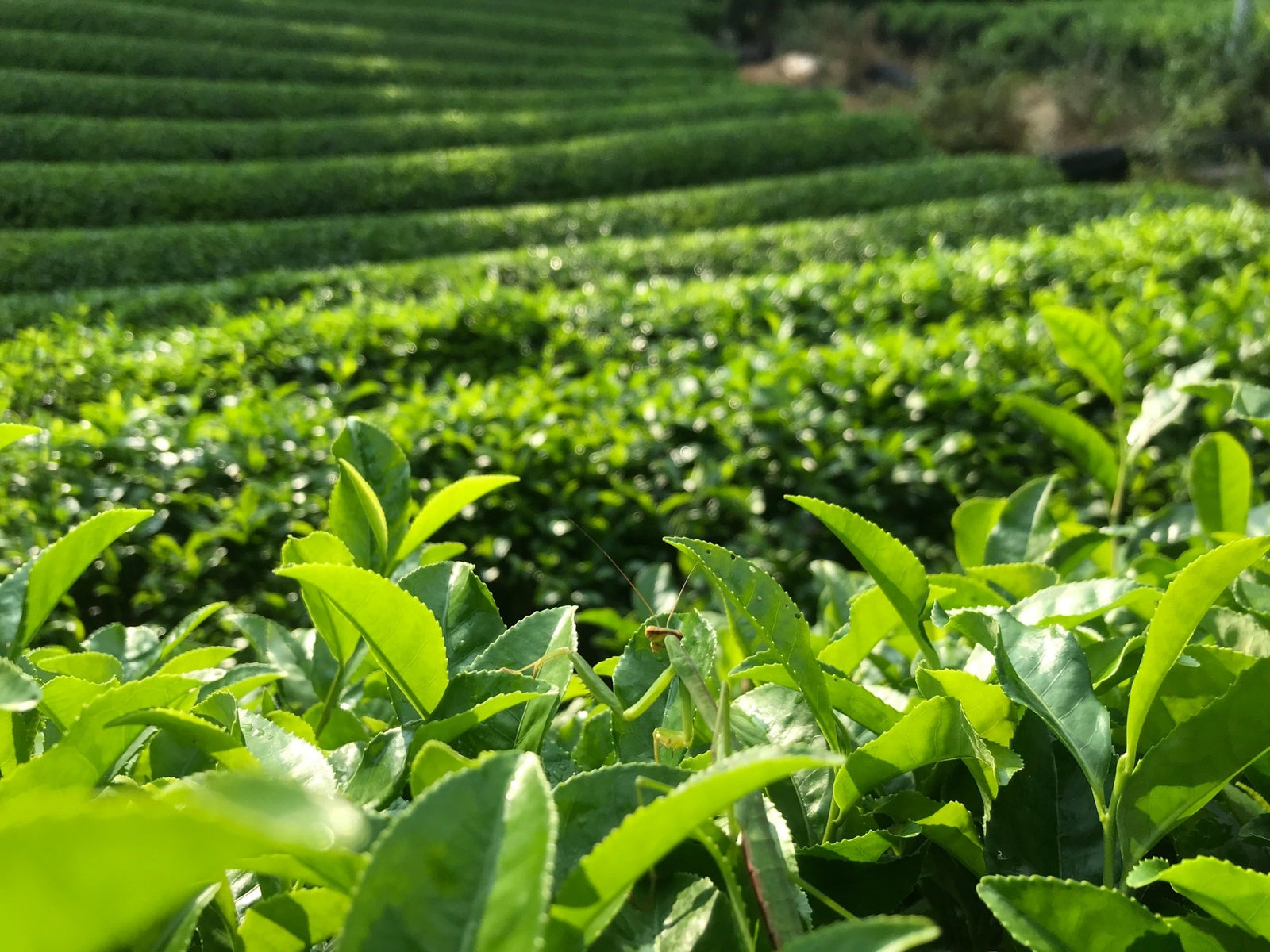こんにちは! 和束町の美しい茶畑でカマキリがくつろいでいるのを見つけられますか?はい、今日は京都府の主要な茶産地をご紹介する回です。今回は、京都府の南端に位置する心温まる町、和束町にスポットライトを当てます。
雄大な茶畑の風景
素敵な和束町を初めて訪れたのは2019年の夏(コロナ禍以前)、日本の非営利団体NICEが主催する茶業、有機農業、日本文化に関する国際ボランティアワークキャンプに参加するためでした。日本の田舎の風景は、山々や田んぼ、伝統的な家屋といった自然の美しさで知られています。しかし、瓦屋根の集落の中に茶畑が広がる壮大で芸術的な景観に、これほどまでに畏敬の念を抱いたのは初めてでした。後に和束の茶農家の方から、この景色は800年以上にわたるこの地域の茶生産の歩みを示しており、日本の緑茶が発祥の鎌倉時代(1199-1334)と並行していることを知りました。おそらく、人の目にとても美しく見える理由の一つは、和束の茶樹が年間を通して複数回(日本中の他の多くの茶園よりも多く!)刈り取られ、手入れされているためでしょう。このように茶畑を区画することで、茶農家は茶の木を丁寧に育て、茶樹への日照量を最適化することができます。さらに、宇治や宇治田原など、日本有数の銘茶の産地として知られる周辺地域と同様に、和束町は気候、湿度、霧、寒暖の差など、お茶作りに適した地理的条件を備えています。2015年には、和束町は日本遺産に登録されました。チャノキは常緑樹であるため、一年を通して素晴らしい景色が楽しめることが想像できます。
石寺茶畑は、おそらく和束で最も有名な茶畑でしょう。この象徴的な景観は、様々な茶製品に利用されてきました。春には、この美しい茶畑のすぐそばで桜並木を楽しむことができます。
原山:すべてが始まった円形茶畑
和束町では、文字通りどこにでも茶畑があり、思いもよらない場所にも茶畑があります。非常に急な斜面でも開墾(森林を伐採して農地を作る作業)を行った和束町の茶農家の人々の努力に感謝することでしょう。茶畑の手伝いをする機会があれば、農場のトラックの荷台に乗り、急な坂を上り、ヘアピンカーブを曲がって茶畑に向かうのは、とても思い出深く、冒険的なものになるでしょう。和束町のユニークな茶畑の一つが原山の茶畑で、 「円型茶畑」としてよく知られています。実際、この茶畑の対称的な美しさ、自然と人の手の優雅なダンスに魅了されないのは難しいことです。原山は、和束町で最初に茶の木が植えられた場所でもあると言われています。では、お茶の種はどこから来たのでしょうか?これらは、日本の茶業の開祖である明恵上人から、海住山寺の僧侶である慈真に贈られたものです(この地域の茶の歴史を少しおさらいしたい方は、 宇治と宇治田原の記事をご覧ください)。自然に囲まれているので、ハイキングコースとしても楽しめます。町では電動自転車もレンタルできます。私はあまり好きではないのですが、電動自転車を使うとより快適に走れると感じました。つまり、電動自転車が坂を上るのを助けてくれるので、それほど苦労することはないということです!
 原山の茶畑の左右対称の美しさは、時として人を催眠状態に陥れる。写真は岸田萌氏による。
原山の茶畑の左右対称の美しさは、時として人を催眠状態に陥れる。写真は岸田萌氏による。
今日の和束茶
現在、和束町は日本の茶の生産量のわずか2%ほどしか占めていません(茶の生産量の約45%は京都府)。しかし、和束茶(和束町産のお茶)は、特に旨味が豊かな高品質のお茶として知られています。伝統的に、この地域は煎茶(和束町の北西約10kmにある宇治田原町で開発された)で非常に有名であり、そのため、茶農家は以前は煎茶のみを生産していました。しかし、約15年前、和束町で抹茶の生産がほとんど行われていなかった時期に、多くの和束町の茶農家が碾茶も生産し始めました。例えば、上島製茶園の個人経営の碾茶工場は比較的最近の2016年に設立されました。現在、彼の茶の生産量は、煎茶が30%、碾茶/抹茶が70%を占めています。これは、日本だけでなく和束町の茶業の状況を反映しています。つまり、抹茶の需要が高まっているということです。
和束町は全国的に見るとお茶の生産量は多くない(例えば、お茶の主要産地である静岡県や鹿児島県と比べると)のですが、京都府内では茶畑の面積、茶農家戸数、お茶の生産量において第1位を誇ります。
表1. 京都府における茶種別荒茶生産量(単位:トン). 統計資料:京都府茶業振興局, 2013. 
表2. 京都府のお茶ランキング。 2013年京都府茶業協会統計より。 
和束茶カフェ
この素敵な小さなカフェは、和束茶の豊富な品揃えを堪能できる最高の場所です!上島茶園の上島家は、このカフェを経営する家族の一つです。上島さんへのインタビューでは、和束茶カフェの歴史についてお話を伺うことができ、大変興味深く思いました。
上島さん: 「昨年はコロナ禍で和束茶カフェにとって異例の一年でしたが、今では売り上げが4万円ほどの黒字になりました。創業メンバー4人でこのカフェを始めようと決めた当初とは全く違います。全く売れない日もありました。レジの引き出しがびくともせず、“チーン”という音もしない! レジが錆びるのを防ぐために、100円ドリンクを自分で買わなければならない時もありました…。実は、そんな暗い時期が3~4年ほど続きました。お客さんが来てくれればまだよかったのですが、最初の頃は他の農家さんからバカにされたんです。『こんなところで誰がお茶を買いに来るんだ?』って。すごく疑心暗鬼だったんですよ」 「6年目くらいから軌道に乗り始め、10年目には本格的に売れるようになりました。それは社会の変化があったからです。地域振興や文化振興活動の中に、茶畑の観光やお茶を飲むことが含まれるようになりました。SNSやマーケティングを通して、和束町外からも人が来るようになりました。観光バスの力も借りられました。京阪バスの社長さんが『京の茶』ルートを担当されているので、京都南部を通るルートを開拓してほしいとお願いしたんです」
 和束茶カフェのお茶のセレクション。座ってお茶を楽しみながら、デザートもお選びいただけるスペースもあります!写真は和束茶カフェより。
和束茶カフェのお茶のセレクション。座ってお茶を楽しみながら、デザートもお選びいただけるスペースもあります!写真は和束茶カフェより。
心温まる街、心温まる人々
和束町で私が強く印象に残ったことの一つは、茶農家の方々やこの町の人々の、故郷を深く愛し、土地と人々に深く根付いた茶文化を分かち合おうとする優しさだったかもしれません。もし和束町を訪れる機会があれば、たとえ日本語が話せなくても、ぜひ地元の人々と交流してみてください。和束茶カフェや、毎年開催される茶源郷茶祭り(注:ウェブサイトは日本語です)などがおすすめです。あるいは、地元の銭湯にも足を運んで、この地域の方言を聞くのも良いでしょう。

 京都府和束町で、西山家と秋の茶摘み(写真上)。茶農家の方々、友人、そして茶摘みを手伝ってくれるボランティアの方々が、西山さんの家によく集まり、 お好み焼き(写真下)を楽しんでいます。茶摘みだけでなく、西山さんはお好み焼き作りも本当に上手なんです!写真はジミー・バーリッジ。
京都府和束町で、西山家と秋の茶摘み(写真上)。茶農家の方々、友人、そして茶摘みを手伝ってくれるボランティアの方々が、西山さんの家によく集まり、 お好み焼き(写真下)を楽しんでいます。茶摘みだけでなく、西山さんはお好み焼き作りも本当に上手なんです!写真はジミー・バーリッジ。
湯呑みと和束茶農家の絆
もちろん、今は和束町を訪れて和束茶カフェでお茶を買うのに最適な時期ではないかもしれません。しかし、Yunomiでは、勤勉で心温まる茶農家の方々が作ったお茶を豊富に取り揃えています。
- 上島茶園:和束町、そして日本茶界で最も有名な茶農家の一つ。上島さんは、お客様に喜んでいただけるお茶を丁寧に淹れ、「茶の間」(お茶を淹れて、お客様に振る舞う時間と空間)を大切にし、心を満たすお茶をお届けすることをお約束します。これらの点は、先日行われた上島さんへのインタビューでも詳しく語られていますので、ユーモアあふれる感動的なお話もぜひご覧ください。
- 京都おぶぶ茶園:おぶぶ茶園がなかったら、もしかしたら今の湯呑みは存在していなかったかもしれません!おぶぶ茶園のユニークな点の一つは、インターンシップや研修コースを提供していることです。日本で茶栽培や茶に関する知識の習得に興味のある方にとって、おぶぶ茶園はまさにうってつけの場所かもしれません。ウェブサイトは英語にも対応しており、ユーモアあふれる内容も満載です。実際、 おぶぶ茶園のヤギたちが投稿するブログ記事も興味深いかもしれません。
-
喜六茶園:和束町にあるもう一つの茶園、喜六は、夫であり父でもある方の逝去後も茶園を守り続けたいと願う、素晴らしい3人の女性によって運営されています。彼女たちは、100%シングルオリジンのお茶を生産する上で、時に過酷な茶作業に穏やかなバランスを与えてくれる猫たちの力強さに支えられていると言います。次回は、姉妹の一人である恵さんへの最近のインタビューをお届けします。
 写真提供:喜六茶園
写真提供:喜六茶園
- 中井茶園:中井家は17世紀から和束町で茶を栽培してきました。1980年、6代目茶匠の中井正雄氏が有機栽培・無農薬栽培を始めました。当時、日本で有機栽培への関心がまだ低かった時代です。現在、息子の中井道雄氏が誇りを持って、高品質な有機栽培茶を生産し続けています。
- 阿津間茶園:抹茶好きの方なら、阿津間茶園はお馴染みの名前かもしれません。秋のYunomiでは、阿津間さんの10種類の抹茶の試飲セットをお届けできて大変嬉しく思っています。あっという間に完売してしまいましたが、抹茶をはじめとする様々なメニューは引き続きお楽しみいただけます。
京都南部の山間にひっそりと佇む隠れた茶の里、和束町について少しでも知っていただけたら幸いです。和束茶に乾杯!
特集画像のクレジット:水浴びをするカマキリの茶畑。日本、和束町。撮影:岸田萌。


